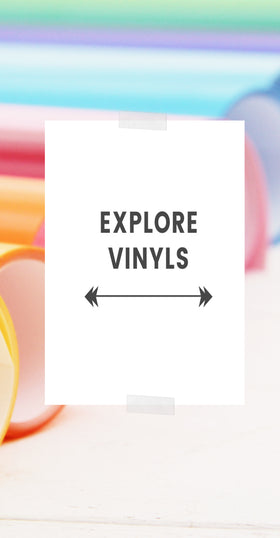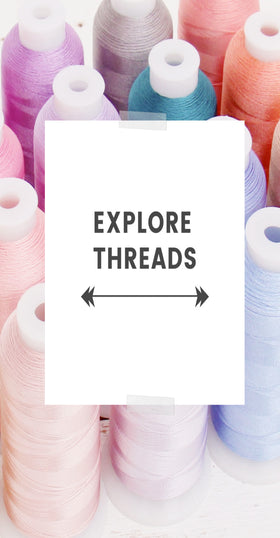Arrives in 2-6 Days

What is the difference between heat transfer vinyl and adhesive vinyl
If you're new to the world of crafting, or even if you're a seasoned pro, I bet you've had your moments of confusion with the myriad names, materials, and processes of vinyl crafting. No worries, I'm here to clear up the confusion and teach you the difference between Heat Transfer Vinyl (HTV) and Adhesive Vinyl. Spoiler alert: they're totally different. So, let's dive in!
To start with, let's clarify one thing: crafting with vinyl involves creating designs and applying them to a wide variety of products, whether it be clothing, accessories, or home decor. You can use a software like Cricut Design Space or Silhouette Studio to create these designs. Now, the big question, what’s the difference between Heat Transfer Vinyl and Adhesive Vinyl?

Adhesive Vinyl: Your DIY Sticker
Think of Adhesive Vinyl as a DIY colorful sticker. This type of vinyl has a sticky backside, just like a regular sticker, and is ideal for non-fabric materials.
The process of applying Adhesive Vinyl to your project involves several steps:
- Design and Cut: Open up your crafting software and create your design. Then, select vinyl in your cut settings, load your Adhesive Vinyl onto your cutting mat, and cut your design.
- Weeding: Use your weeding tool to peel off the vinyl you do not want. The remaining vinyl will be your final design.
- Transfer: Use a piece of transfer tape to move the design from the vinyl backing sheet to your project. Smooth it out to ensure a good adhesion.
- Apply: Finally, remove transfer tape and rub your design onto the material.
Just remember that Adhesive Vinyl has two layers: the colorful vinyl itself, and a backing sheet. The backing sheet holds all your pieces together until it's time to transfer.
Pro tip: When putting a design onto a material that will get used a lot, it's better to stick with permanent glossy vinyl. It has a stronger adhesive.

Heat Transfer Vinyl: Iron-on Designs for Fabric
Heat Transfer Vinyl (HTV), on the other hand, is ideal for fabric materials. Unlike Adhesive Vinyl, HTV is heat activated and requires a heat press (or a simple home iron) to apply.

Here are the steps to follow:
- Design and Mirror: Just like Adhesive Vinyl, you need to create your design. However, there’s one crucial difference: you need to mirror your image before cutting because the cutting machine will cut on the back side of HTV.
- Cut and Weed: Set your cutting machine to HTV settings and cut your design. Afterwards, weed away the excess vinyl.
- Heat Transfer: Use a heat press or an iron to apply your design onto the fabric. Remember, the key word here is 'heat.' HTV needs heat in order to transfer.
- Peel Off: Peel off the clear carrier sheet according to instructions. It could be hot peel or cool peel.
Note: Heat Transfer Vinyl has two layers too: a thin layer of the vinyl that is heat activated, and a clear carrier sheet. This is what allows us to create an intricate design without having to place each piece individually.

Quick Recap
Now, to summarize, here are the main points you need to remember about HTV and Adhesive Vinyl:
-
Adhesive Vinyl: This type of vinyl is great for non-fabric materials. It needs transfer tape and is essentially a "colorful sticker". It's cut right side up and has
two layers: the adhesive vinyl itself and a backing sheet. Shop adhesive vinyl.
- Heat Transfer Vinyl (HTV): This is perfect for fabric materials. It has two layers: the heat activated vinyl and a clear carrier sheet. The design needs to be mirrored before cutting, and requires heat and pressure to apply to fabric. Shop all heat transfer vinyl
And that's it! Now you've learned how to work with both Adhesive Vinyl and Heat Transfer Vinyl. You're on your way to becoming a vinyl crafting expert! Always remember, the key to mastering any craft is practice, so don't hesitate to try out different designs and techniques. Check out Threadart for a wide range of vinyl products to kickstart your crafting journey.
Happy Crafting!



